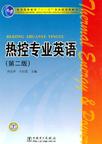热控专业英语
出版时间:2010-8 出版社:中国电力出版社 作者:齐宪华,于红霞 主编 页数:235 字数:368000
前言
本书是为适应高等院校专业英语教学的需要,依据热控专业的教学要求编写的,其主旨是提高学生读译专业英语的能力和水平。 本书包括33个单元,共六部分。涉及自动控制原理、计算机的基本知识、热工检测技术、热工自动控制系统、热工保护、顺序控制、可编程控制等热控专业知识。每个单元后列出了专业词汇,并对课文的难点内容进行了注释。 编者在教学、科研、现场实践等多个环节积累了丰富的材料,每个单元的内容均提炼于此。本书的选材简练生动,单元的长度和设置符合教学要求。 本书由山东电力高等专科学校齐宪华副教授和沈阳工程学院的于红霞老师主编。齐宪华编写了第一部分,第二部分,第三部分的15、19、20单元,第四部分的21~24单元及27单元,第五部分的28~30单元,以及全书的词汇和附录;于红霞编写了16、17、18、25、26、31单元及第六部分;山东鲁能控制工程有限公司王硕参与了图形绘制并承担了部分编写任务。全书由齐宪华统稿。 本书由长沙理工大学潘维加教授和山东大学张承进教授主审。主审老师对本书进行了认真审阅,提出了许多宝贵意见,付出了辛勤的劳动。在此,编者表示衷心的感谢。 本书在收集材料过程中也得到了学校和电厂的大力支持,在此一并表示感谢。 在编写的过程中,由于时间仓促,水平所限,难免有一些疏漏之处,敬请读者指正。
内容概要
本书为普通高等教育“十一五”国家级规划教材。 本书包括33个单元,共六部分,内容涉及自动控制原理、计算机的基本知识、热工检测技术、热工自动控制系统、热工保护、顺序控制、可编程控制等热控专业知识。每个单元的学习材料均由编者从教学、科研、现场实践等多个环节提炼而来,简练生动,单元的长度和设置符合教学要求。每个单元后列出了专业词汇,并对课文的难点内容进行了注释。 本书可作为本科能源动力类和高职高专电力技术类相关专业的专业英语教材,也可作为科技人员和现场运行技术人员的培训教材和自学参考书。
书籍目录
前言Part Ⅰ Control Principle Unit One Introduction to Control Systems Unit Two Feedback Control Unit Three Transfer Functions of Linear Systems Unit Four Impulse Response of Linear Systems and Block Diagram Unit Five Time-Domain Analysis of Control Systems Unit Six Root Locus Techniques Unit Seven Stabilization and Improvement of Transient Response Unit Eight Improvement of Static Accuracy Unit Nine Introduction to Stability of Control Systems Unit Ten Applications of Automatic ControlPart Ⅱ Computer Technique Unit Eleven Basic Computer Architecture Unit Twelve Conversions Between Analogue and Digital Signals Unit Thirteen Microprocessors in Control Applications Unit Fourteen Computer-Controlled SystemsPart Ⅲ Measurement Instrumentation Unit Fifteen Process Instrumentation Unit Sixteen Temperature Measurement Unit Seventeen Pressure Measurement Unit Eighteen Flow Measurement Unit Nineteen Digital Transducers Unit Twenty Control and InstrumentationPart Ⅳ Thermal Automatic Control Systems Unit Twenty-one Introduction to Modern Power Plant Unit Twenty-two Introduction to Instrumentation and Control in Thermal Power Plant Unit Twenty-three Boiler and Turbine Controls Unit Twenty-four Coordinated Control Systems Unit Twenty-five Distributed Control Systems Unit Twenty-six Process Control Trend Unit Twenty-seven Control Systems DesignPart Ⅴ Protection Systems Unit Twenty-eight Logic Circuits Unit Twenty-nine Logic Control and Protection Systems Unit Thirty Sequence Control Systems Unit Thirty-one Programmable Logic Controller(PLC)Part Ⅵ Fieldbus Unit Thirty-two Introduction to Fieldbus Unit Thirty-three Application of FieldbusAppendix参考文献
章节摘录
In recent years, automatic control systems have assumed an increasingly importantrole in the development and advancement of modern civilization and technology. Domesti-cally, automatic controls in heating and air conditioning systems regulate the temperatureand the humidity of modern homes for comfortable living. Industrially, automatic controlsystems are found in numerous applications, such as quality control of manufacturedproducts, automation, machine tool control, modern space technology and weapon sys-tems, computer systems, transportation systems, and robotics. Even such problems as in-ventory control, social and economic systems control, and environmental and hydrologicalsystems control may be approached from the theory of automatic control. The basic control system concept may be the simpleblock diagram shown in Fig. 1.1. The objective of the sys-tem is to control the variable c in a prescribed manner bythe actuating signal e through the elements of the controlsystem. In more common terms, the controlled variable is the output of the system, and the actua-ting signal is the input. As a simple example, in the steering control of an automobile, the direc-tion of the two front wheels may be regarded as the controlled variable c, the output. The posi-tion of the steering wheel is the input, the actuating signal e. The controlled process or system inthis case is composed of the steering mechanisms, including the dynamics of the entire automo-bile However, if the objective is to control the speed of the automobile, then the amount ofpressure exerted on the accelerator is the actuating signal, with the speed regarded as the con-trolled variable.
图书封面
评论、评分、阅读与下载
用户评论 (总计2条)
- 正版,内容算是比较全面的。还不错。
- 现在的作者太不负责任了,我大体翻了翻,竟然发现前三分之一部分完全照抄外文书的内容,连图都没变,而且最后的参考文献中也没注明,我觉得它也不敢注明吧!作者难道不清楚编著和抄袭的区别吗??可想而知后面三分之二部分应该也是从某些书上抄来的,这种书都可以成为所谓“国家级优化教材”吗?
